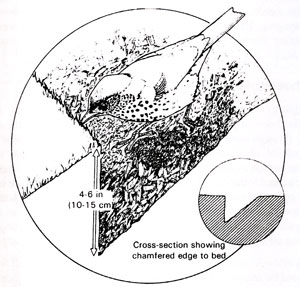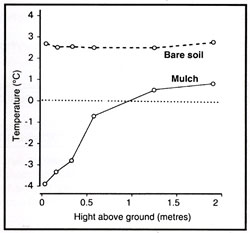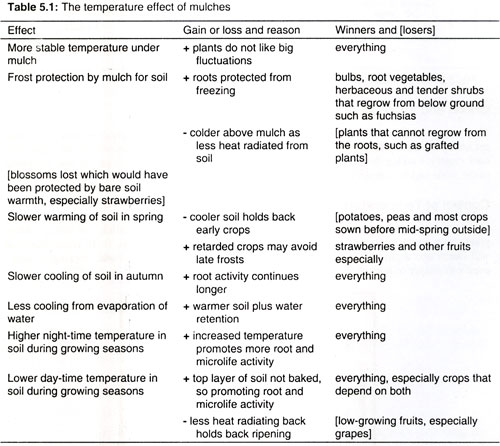Why Mulching is Essential?
These are among the commonest reasons for mulching, especially with manures or composts, although to a lesser degree with many other materials. When manure or compost is incorporated into the soil the stimulated microlife breaks down the material and releases much of its nutrient value and provides perfect conditions for a newly planted tree or a heavily feeding vegetable during the growing season. This may cause leaching of fertility, especially in wet weather and whenever there are insufficient active root systems to absorb it. A mulch using the same material is likely to break down more slowly, and any leaching has to pass through the entire depth of the soil, thus considerably reducing the chance of its being lost.Mulch and Microlife Activities
The presence of a mulch increase microlife activity in the soil because it provides warmth and moisture. The increased microbial activity then enriches the soil as the microbial biomass and leaves more by-products. This activity also unlocks nutrients bound into soil particles; in particular the amount of exchangeable potassium in the soil is increased. Mulching practice for each year increases the depth of soil enriched.
Activity of Earthworm
The burgeoning life is easily seen when a mulch is removed: the numerous earthworm holes and droppings testify to their activity. These animals improve the drainage and aeration with their system of burrows, and so further aid other microlife and fertility. Worms work up into the mulch and leave many droppings, often deposited on top, especially on sand mulches. These casts are extremely rich in nutrients and have a water-stable texture.
Weed Suppression
Mulches help in weed suppression. Use of a shallow mulch on top of established weeds may look neat immediately, but after a very short time they will have grown through. Worse, they will be even more vigorous, as the mulch will suit them and eliminate a few of their weaker competitors. If the weeds are small, low-growing and do not include vigorous spreaders like ground ivy, nettles, thistles, Equisetum (horsetail) or bindweed then thick mulches will kill them. Straw is easiest to apply in bulk and the cheapest too. Spread at least lft (30 cm) thick in spring it will eradicate many of the weeds, but any that do emerge must be pulled and destroyed straight away to prevent them rampaging. Extra layers of mulch applied every time the weeds reappear will be effective at suppressing them, but may require enormous amounts of material. Impenetrable mulches are much easier.
Impenetrable Sheets of Plastic
As all plants need light to survive. Even tough, established we^ds can be suppressed by providing cover of impenetrable sheets of plastic, woven fabric or old carpet. Anything less sturdy will allow these weeds to romp through even immense thickness of loose mulch. It helps to surround the area with a narrow trench of about a spade-spit wide and deep, to prevent reinforcements. The impenetrable sheet as mulch is used in early spring, when it flattens the weeds which have just started to grow. Earlier and it has to cope with harsh weather; later and there is a chance that some early weeds such as celandines may return to dormancy for a year. During late spring holes can be cut through and crops such as courgettes, sweetcorn, tomatoes or brassicas planted into the soil underneath. Even ornamental shrubs can be planted like this if they are pot-grown, but they will need copious watering all summer, as they are so much less vigorous than vegetables.
Provided no weed is allowed to reach the light the area will be cleared of all weeds by the autumn, when the sheets should be removed for soil cultivation. Organic materials can be left to rot in situ, but plastic and long-lasting woven sheets will degrade eventually and their removal then becomes tedious, particularly if weeds are ever allowed to grow through them. If the sheets are laid to kill weeds in paths or drives, on the other hand, they can be graveled over the left. They could also remain under trees or shrubs but will look unsightly; a skim of shredded bark or other loose mulch will dramatically improve their appearance.
If a horticulturist desires to mulch the area with organic matter, obviously an impermeable sheet must be removed or all the benefits will be lost; but if the mulch is lonely for aesthetic reasons, the sheet can be left, though holes should be made with a fork to allow air (rather than water) to reach the soil.
Once the established weeds have gone, any mulch will help control new ones by preventing seed germination. For this either an opaque fabric sheet or a loose mulch at least 2-3 in (5-7.5 cm) deep is necessary.
Birds and Mulch Disturbance
For a careless horticulturist, birds are the main cause of mulch disturbance. Birds kick the mulch backwards and work towards obstacles. If the edge of the path or lawn is made 4-6 in (10-15 cm) deep and the bed is chamfered away from it the birds will face the perpendicular surface, kicking the mulch up onto the bed.
 |
| Fig. 5.1: Keeping bark mulch in place. Correct edging discourages birds from spreading mulch onto adjacent lawn. |
Loose Non-organic Mulches
Loose non-organic mulches do not settle or become incorporated as much, though the finer-textured ones can become degraded by worm casts. These are usually deposited in or under organic mulches and on top of non-organic ones, especially sands, causing no problem in themselves, but containing weed seed and providing suitable conditions for germination.
Sometimes, weeds may germinate in a loose mulch and they are initially easy to pluck out but rapidly become established, and then much of the mulch is dragged up with them when they are removed. Hoeing is the solution, however, it is often difficult through a mulch.
Mulch and Retention of Moisture
Mulch help in retention of soil moisture and help in water economy of soil. During increasing frequency of summer droughts and day winters means that mulches are being used more and more to ensure that as little water as possible is lost. It helps in following ways:
- In absence of mulch, water is continually pulled from the subsoil by capillary action and evaporates from the surface.
- It interrupts the flow by hindering the evaporation, trapping the water in its air spaces.
- Mulch ensures that the soil remains moist all the way to the surface, thus increasing the volume available for microlife and plant activity.
- The rough surface of a mulch further reduces evaporation by breaking up the airflow, in the same way as a hedge does on a larger scale.
- The mulch breaks the impact of heavy rain and then allows it to percolate, it prevents soil impaction and keeps the surface permeable, preventing excessive run-off and soil erosion.
The water saving is great: where bare soil will take three to five days to evaporate (1 cm) of water, a mulched soil takes six weeks. If there is heavy rain there is little problem, as it will quickly drive through many mulches, but when brief showers predominate it is necessary to rake the mulch aside and allow the rain to reach the soil.
Impenetrable sheets such as plastic are first-rate for water retention, but a few points for their use must be noted.
 |
| Fig. 5.2: Water-holding mulch. |
Gravel and Stone Mulches
They increase the availability of water and so tend to be used more in hotter climates. The stone get hot on top during the day, expanding and driving out the air from underneath; in the night, they cool rapidly, sucking the air back into the spaces where the dew condenses on the cool underside of the stone and runs down into the soil.
Control of Temperature
Mulch monitors temperature of the soil (above and below mulches). Mulch has critical effect, plants, as it works as an insulating blanket. It protects roots in the soil from frost. Where bare soil will freeze to a depth of 2 in (5 cm), the same thickness of mulch will prevent freezing entirely -even a thin layer of litter gives considerable protection.
 |
| Fig. 5.3: Mulch cools air temperature above ground. |
Soil under a mulch has a more even temperature range and is warmer for most of the year. This insulation limits heat loss at night and keeps the average soil minimum temperature slightly higher than in un-mulched soil throughout most of the year. At the same time, the average soil maximum temperature remains lower, especially through the heat of summer, thus creating those more stable conditions of warmer soil at night and cooler during the day which most plants require.
Mulches, therefore, are good at protecting roots from frosts but may prove fatal to top growth. An understanding of this heat exchange process enables you to devise your own permutations.
 |
| Table 5.1: The temperature effect of mulches |
After a mulch is removed the soil will be in a much better condition than if it had been left bare. The combination of worm and other activity, favourable physical conditions and a lack of rain impaction gives most soils that crumbly brown-sugar texture beloved by gardeners and plants. Mulches on empty ground as a winter cover against soil erosion and leaching will also produce a good tilth without the digging and raking otherwise required.
Protection Soil against Erosion
Mulches protect the soil against erosion in several ways. They break the impact of heavy rain and prevent drying, stopping the granular soil that has formed being broken down into finer particles which would be more easily washed away. While the mulch remains the soil cannot be blown about or form a crust. It also helps prevent the formation of rivulets, which would cause further erosion.The texture of soil is improved more deeply as mulching continues over several years and as more material breaks down and becomes incorporated. Even inorganic mulches such as sharp sand can improve texture.
Control of Pest and Disease
Mulches provide extra benefits in disease prevention and control soil microlife. The warm moist conditions under the mulch also break down many of the dormant over wintering organisms.
Many diseases such as rose black spot over winter on layer of mulch is applied on top of this infective material after leaf-fall it is sealed in and cannot be splashed back onto the plant to restart the cycle in spring. Thus disease prevention may be an unnoticed side-effect, as when horse manure is applied to roses, and when strawberries and gooseberries are strawed. Mulching can also protect indirectly against mildews, which are often aggravated, if not caused, by insufficient water; a moisture-retaining mulch will reduce attacks.
Apart from encouraging the soil microlife with nutrients, warmth and moisture a mulch also forms a good home for many larger creatures. Woodlice, for example, process the material and break it down; they then provide a basic food source for shrews, birds and hedgehogs, which help to control other more harmful bugs.
Mulches will further assist in the control of some pests such as per midge, gooseberry sawfly and raspberry bettle. Many pests such as these can be brought to the surface to be picked off or left for the birds, if the area is well watered and then covered overnight with a sheet of black plastic or old carpet. Sheets of impenetrable mulch can be even more effective. If they are put down before the pupae emerge, the pests are trapped underneath, die and are converted to soil fertility, sward the next day, especially in hot conditions, unless you wish to kill the grass as well.
Appearance
Gardeners use mulch for its appearance. An attractive covering is certainly pleasing to the eye and acts as an excellent foil to plants. The problem of cost against aesthetic value can be answered by using a thin layer of attractive mulch on top of a cheaper or more effective kind. Mulches also come into their own where it is desirable to keep plants clean. Thin fabric or horticultural paper laid on the ground are excellent materials to protect salaaming, especially spinach, from soil splash. Gravel can also be used for this purpose.




